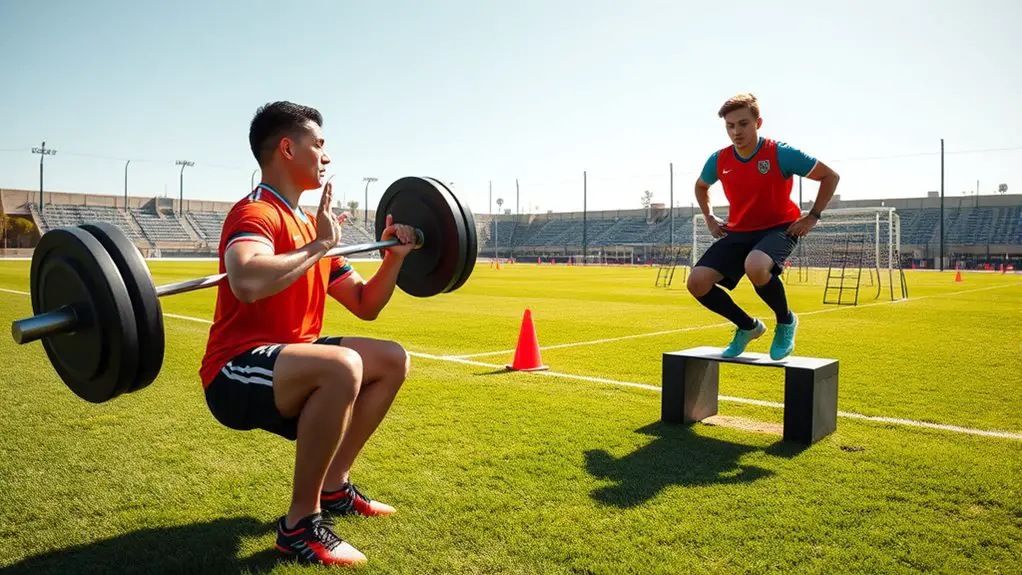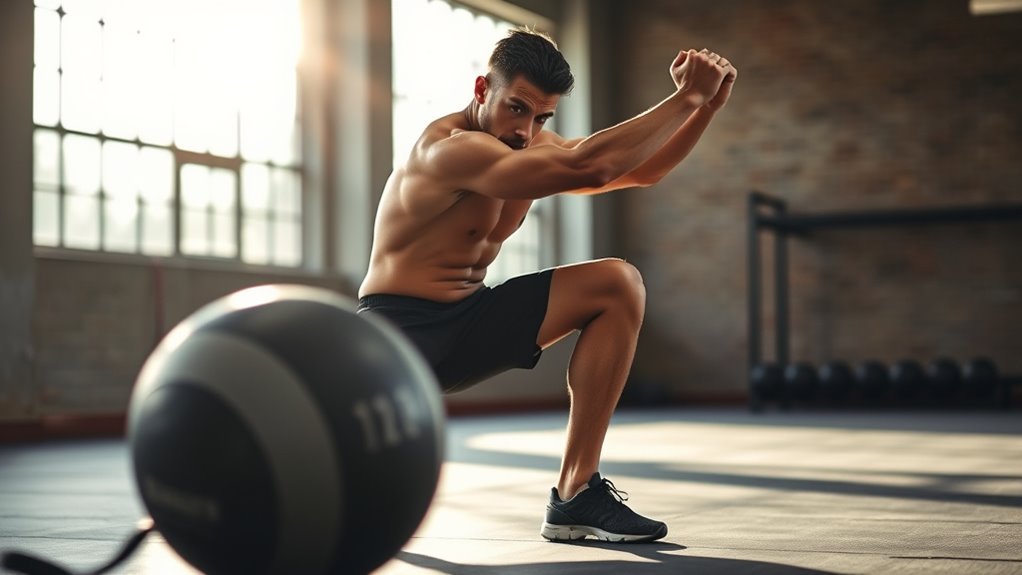Strength workouts for soccer players are essential for enhancing performance and preventing injuries. Focus on key muscle groups like your core, legs, and upper body. Incorporate squats, lunges, and planks for lower body stability and core strength. Don't forget explosive movements like deadlifts to improve sprinting power. Also, include exercises for shoulder strength to aid in ball shielding. By committing to these workouts, you'll boost your game considerably and discover even more workouts that could benefit you.
Importance of Strength Training for Soccer Players
While you might think of soccer as primarily a game of speed and agility, strength training is crucial for enhancing your performance on the field. It's not just about running fast or dribbling; building strength can give you that extra edge. Strong muscles help you maintain balance, resist tackles, and execute powerful shots, which translates to better overall gameplay.
Additionally, strength training plays an essential role in muscle recovery. After intense matches or training sessions, your body needs to repair and rebuild. By incorporating strength workouts into your routine, you're not only improving your performance but also speeding up recovery time, allowing you to get back on the field sooner. Moreover, commitment to strength training leads to significant skill and performance improvements, ensuring you unlock your full potential on the field.
Key Muscle Groups to Target
When it comes to strength training for soccer, focusing on key muscle groups can make all the difference. You'll want to prioritize core stability and strength, build leg power and endurance, and condition your upper body. Targeting these areas will enhance your performance on the field and help prevent injuries. Incorporating strength training for core stability into your routine is essential for improving skills like dribbling and shooting.
Core Stability and Strength
Core stability and strength are essential for soccer players, as they enhance overall performance and reduce the risk of injury. Focusing on your core helps you maintain balance and control while traversing the field. Here are four key muscle groups to target:
- Abdominals: Strengthen your core for better stability.
- Obliques: Develop rotational strength for powerful turns and shots.
- Lower Back: Support your spine to prevent injuries during intense play.
- Hip Flexors: Improve your agility and movement efficiency.
Incorporating balance training into your routine can further enhance your core's effectiveness. By targeting these muscle groups, you'll gain the freedom to maneuver confidently and perform at your best on the pitch.
Leg Power and Endurance
To excel in soccer, building leg power and endurance is essential, as strong legs enable explosive movements and sustained performance throughout the match. Focusing on key muscle groups like your quadriceps, hamstrings, and calves can make a significant difference. Incorporate leg drills such as squats and lunges to strengthen these muscles, while also enhancing stability. Plyometric exercises, like box jumps and jump squats, will boost your explosiveness, allowing you to sprint past opponents with ease. Don't forget to integrate agility drills to improve your overall speed and balance. By committing to a routine that targets these areas, you'll gain the strength and endurance needed to elevate your game and experience the freedom of movement on the field.
Upper Body Conditioning
Upper body conditioning is essential for soccer players, as it enhances overall performance on the field. Strong upper body muscles help you maintain balance, improve your passing, and shield the ball effectively. Here are some key muscle groups to target with your conditioning techniques:
- Shoulders – Build strength for powerful throws and stability during tackles.
- Chest – Enhance your shot power and ability to hold off defenders.
- Back – Improve posture and support your arm movements during play.
- Arms – Boost your passing precision and help with ball control.
Incorporating these upper body conditioning techniques into your routine will elevate your game, giving you the freedom to play with confidence and strength.
Explosive Movements for Agility
While agility is essential for soccer players, incorporating explosive movements into your training can greatly enhance your performance on the field. By focusing on plyometric drills and agility ladders, you'll improve your speed and quickness, giving you the freedom to maneuver gracefully during games. Plyometric training relies on the stretch-shortening cycle of muscles, allowing for maximum power output.
Here are some explosive movement exercises to evaluate:
| Exercise | Sets | Reps |
|---|---|---|
| Box Jumps | 3 | 10 |
| Broad Jumps | 3 | 8 |
| Lateral Bounds | 3 | 12 |
| Agility Ladder Drills | 4 | 30 sec |
| Tuck Jumps | 3 | 10 |
These exercises will not only build strength but also develop the fast-twitch muscle fibers necessary for explosive movements. Embrace these drills, and you'll find yourself gliding past opponents with ease!
Core Stability Exercises
Core stability is essential for soccer players, as it helps maintain balance and control during dynamic movements. Incorporating core stability exercises into your routine can make a huge difference in your performance on the field. Here are four effective balance exercises and stability drills to get you started:
Core stability is crucial for soccer players, enhancing balance and control in dynamic movements on the field.
- Plank Variations: Engage your core and improve stability with side planks or plank reaches.
- Bicycle Crunches: These not only target the abs but also enhance rotational stability, vital for soccer.
- Single-Leg Deadlifts: This exercise builds balance and strengthens the core while mimicking movements you'll encounter in a game.
- Medicine Ball Passes: Partner up and throw a medicine ball back and forth to work on core strength and stability. Developing core strength is crucial for connecting the upper and lower body, which enhances overall athletic performance.
Lower Body Strength Workouts
To excel on the soccer field, you need a strong lower body that can generate power and support agility. Focusing on squat variations and lunges techniques will help you build that strength. Incorporate these movements into your training routine to enhance your performance and freedom of movement. Additionally, incorporating plyometric exercises can further improve your explosiveness and agility on the field.
| Exercise Type | Benefits |
|---|---|
| Squat Variations | Builds strength in quads, hamstrings, and glutes |
| Lunges Techniques | Improves balance and coordination, targeting hip flexors |
Try different squat variations like front squats or jump squats to keep things fresh. Lunges can be done in various directions, such as forward or lateral, to challenge your muscles differently. Consistently practicing these workouts will lead to explosive power, allowing you to sprint faster and change direction with ease. Embrace the training and watch your game elevate!
Upper Body Strength and Endurance
As you enhance your soccer skills, don't overlook the importance of upper body strength and endurance. A strong upper body not only supports your overall athletic performance but also contributes to balance and stability during play. To improve your muscular endurance and power, incorporate these exercises into your routine:
- Push-Ups: Great for building chest, shoulders, and triceps strength.
- Pull-Ups: Target your back and biceps, essential for maintaining control over the ball.
- Plank Variations: They engage your core and upper body simultaneously, improving overall stability.
- Dumbbell Shoulder Press: Helps develop shoulder strength, crucial for throwing and shielding the ball.
Additionally, understanding muscle functions can further enhance your training effectiveness and athletic performance.
Injury Prevention Through Strength Training
While you focus on enhancing your soccer skills, don't forget that strength training plays an essential role in injury prevention. Building a solid foundation through strength workouts helps you stay agile and resilient on the field. By improving your muscle strength and balance, you can reduce the risk of common injuries like sprains and strains. Incorporating rehabilitation strategies into your training can also enhance your injury awareness. This means understanding your body and recognizing when something feels off. When you know the proper techniques to strengthen your muscles and joints, you can proactively address weaknesses before they lead to injuries. Additionally, ensuring adequate calcium and vitamin D intake is crucial for strong bones to support your training regimen.
Frequently Asked Questions
How Often Should Soccer Players Incorporate Strength Training Into Their Routine?
Imagine you're a soccer player like Alex, who trains three times a week during the season. This strength training frequency helps build muscle and prevent injuries. However, as the season progresses, you might need to adjust your routine. You can reduce strength sessions to twice a week for maintenance. Always listen to your body and adapt based on your performance and recovery needs, ensuring you're at your best when it counts.
What Equipment Is Necessary for Effective Strength Workouts?
For effective strength workouts, you don't need a gym full of equipment. A set of dumbbells can go a long way, allowing you to perform various exercises that build strength. Resistance bands are another fantastic option; they're portable and versatile, making it easy to work out anywhere. By incorporating these tools into your routine, you can enjoy the freedom to train effectively, no matter where you are.
Can Strength Training Improve My Soccer Skills?
Absolutely, strength training can improve your soccer skills! By building muscle and increasing power, you enhance your overall performance. This leads to better agility and speed on the field, which is essential for skill enhancement. Plus, stronger muscles and joints help with injury prevention, allowing you to play more freely and confidently. So, if you want to elevate your game and stay healthy, incorporating strength training into your routine is a smart move!
Should I Focus on Strength or Endurance During Preseason?
During preseason training, it's like choosing between a lion's roar and a cheetah's speed—both are powerful! You'll want to strike a balance between strength and endurance. Strength builds your power for tackling and shooting, while endurance keeps you running like the wind throughout the game. Focus on both, but if you had to lean one way, endurance might take the edge to guarantee you can outlast your opponents on the field.
How Long Should a Typical Strength Workout Last for Soccer Players?
A typical strength workout should last about 45 to 90 minutes, depending on your training intensity and goals. You want to balance pushing yourself with maintaining proper form. Shorter, high-intensity sessions can be just as effective, so feel free to mix it up! Listen to your body, and don't hesitate to adjust the workout duration based on how you're feeling. Enjoy the freedom to explore what works best for you!




